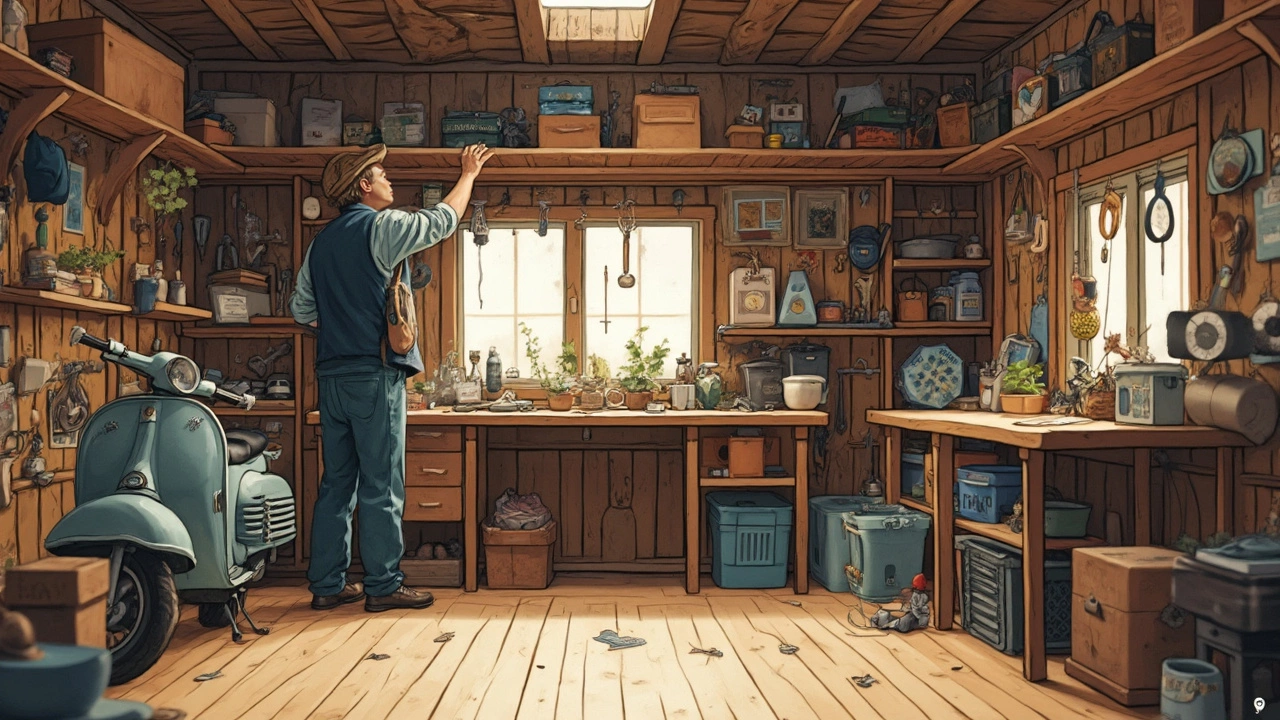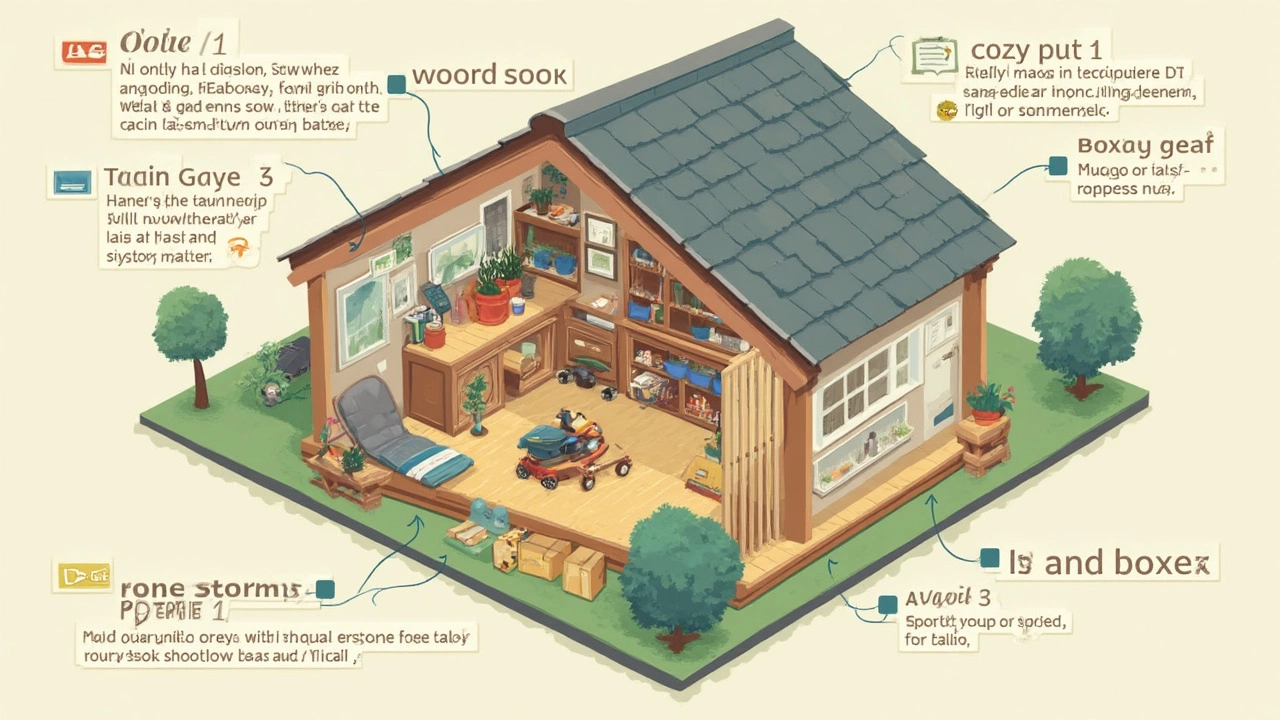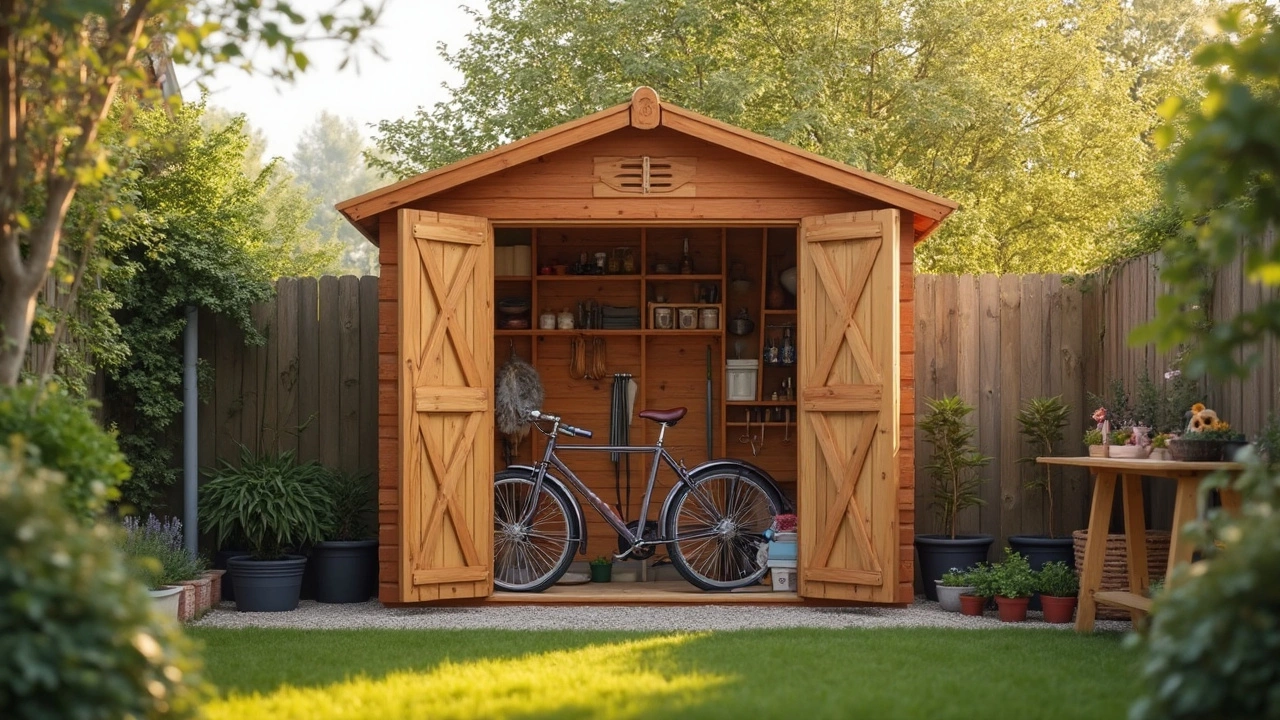Most people see a 10x20 shed and just think, “Big shed, lots of space.” But once you start picturing your stuff inside, it’s easy to either overestimate or undershoot what’ll actually fit. Here’s the nitty-gritty: a 10x20 shed gives you 200 square feet of floor space. That’s about the size of a one-car garage, or two small bedrooms put together. Sounds roomy, right? But whether it really feels that way depends a lot on what you plan to stash—and how smart you are about arranging it.
Been eyeing your cluttered garage or dreaming about a home gym? A 10x20 shed can handle both large and small loads, but there’s a catch: heavy, bulky items like riding lawnmowers or kayaks eat up space fast if you don’t think vertically. Shelves, pegboards, and hanging bins can double or triple your usable room. Before stuffing things in, try chalking out a quick floor plan or just setting boxes against a wall to get a sense of the real-life footprint. Trust me, this saves a ton of backtracking and sore arms later.
- Sizing Up a 10x20 Shed: The Real Space Inside
- What Actually Fits? From Cars to Couches
- Smart Layout Tips: Making the Most of Your Space
- Creative Storage Ideas You’ll Actually Use
- Keeping It Tidy: Avoiding Sheds Full of Regret
Sizing Up a 10x20 Shed: The Real Space Inside
Before stuffing your shed, you’ve got to know what you’re working with. A 10x20 shed gives you a rectangle that’s 10 feet wide and 20 feet long—so, 10x20 shed equals 200 square feet. Now, sheds are often about 8 to 10 feet tall inside, though some go even higher at the peak, which is awesome for hanging bikes or kayaks up out of the way.
Most of us can picture a bedroom or a small living room, but here’s a quick way to see what you can add:
| Common Item | Average Size | How Many Fit in 200 sq ft? |
|---|---|---|
| Queen mattress (on floor) | 33 sq ft | 6 (snug, no walking room) |
| Lawn tractor | 15-20 sq ft | 10-13 |
| Push mower | 6 sq ft | 33 |
| Motorcycle | 18 sq ft | 11 |
| Standard workbench | 16 sq ft | 12 |
Now, nothing says you’ll be filling your shed with only mattresses or only mowers—most people mix it up. And don’t forget the doors, which usually take up 24-48 inches of wall space that you can’t really use for big stuff. Even windows and wall studs eat up a chunk of ‘live’ space. Always measure how much space doors need to open—so you aren’t climbing over your mower just to grab a rake.
Think about headroom, too. Tall shelves or loft storage can free up floor space, and stuff like seasonal bins or bikes can live up high and leave the prime real estate for things you grab all the time. Bonus tip: Sheds with double doors or a ramp let you store bigger things and make them easier to move in or out without dinging walls or your shins.
What Actually Fits? From Cars to Couches
This is where the real fun starts—figuring out what you can actually park, stack, or stash in your 10x20 shed. You’re working with roughly 200 square feet of floor space and a typical ceiling height of eight feet, sometimes a bit higher. If you just need to know, yes, a 10x20 shed can comfortably hold a ton of stuff, but there are real limits.
First up, a full-size car or a couple of motorcycles easily fit inside. Most sedans are about 14-16 feet long, which leaves you a few feet to spare front and back. But if you also want space for bikes, lawn equipment, or storage bins, you’ll need to get creative. Many people use this shed size for:
- Vehicles: One car, or two motorcycles/ATVs with space left for some shelving along the walls.
- Yard Equipment: Riding mower, push mower, wheelbarrow, garden tools, snow blower – and still room to move around.
- Furniture Storage: About the whole contents of a two-bedroom apartment, including couches, beds, dressers, and kitchen tables, if you stack right and take apart what you can.
- Workshop Setup: Workbench, tool chest, plenty of tools, and even large power tools like a bandsaw or table saw if you use wall space for storage.
- Sport & Hobby Gear: Bikes, kayaks, golf clubs, tents, even that old treadmill you keep planning to use.
Want a hard visual? Imagine putting twenty standard washing machines side by side on the floor—that’s your total area. But throwing everything in willy-nilly turns your shed into a no-man’s-land. If you want to fit both a car and stacks of boxes, you’ll need clear zones—a parking zone, a storage wall, and paths to walk through.
One tip: If you’re moving furniture and boxes in, plan for some open floor area near the entrance so you’re not climbing over stuff to find your kid’s winter coat or that box of holiday lights. The best setups leave space to actually use your shed, not just cram it.

Smart Layout Tips: Making the Most of Your Space
The magic of a 10x20 shed is in how you set it up. If you just start tossing things in, you can turn those 200 square feet into one big headache. But with a few tricks, you’ll find it feels almost twice as big. Here’s how people with seriously packed sheds do it—and actually find their stuff later.
- Zone your shed: Break up the area into zones by purpose—like lawn gear up front, bikes by one wall, and holiday bins in the back. Grab some painter’s tape and mark it out on the floor first. This keeps things from turning into a ‘junk mountain’ where nothing’s reachable.
- Go vertical: Shelving is your best friend. Tall shelves along both sides can make use of all that overhead space. Pegboards work great for tools and accessories—especially for things that love to get tangled, like hoses or extension cords.
- Sliding solutions: If you’re stashing a mower or even a small ATV, leave a path down the middle for easy in-and-out. Rolling tool carts or stackable crates mean you don’t have to dig through piles every time you need something small.
- Use corners: Corner shelves or standing racks eat up wasted space. You can even tuck chairs, coolers, or awkward boxes there that don’t fit well anywhere else.
- Don’t forget the ceiling: Add hooks for bikes, ladders, or sports gear. If you’re comfortable with DIY, install a loft platform for bulky seasonal things.
A quick look at what fits, if you plan it smart (all numbers are approximate):
| Item | How Many Fit in a 10x20 Shed* |
|---|---|
| Standard Bicycles | 8-12 (wall-mounted) |
| Plastic Storage Bins | 60-70 (stacked 4 high) |
| Riding Lawn Mower | 1 (plus space to walk around) |
| Workbench and Tool Storage | 1 large setup |
| Full-Size Couch | 2 (with extra floor space) |
*Layout depends on using vertical and corner space, not just the floor!
If you need power for tools or a small fridge, plan electrical outlets before stuffing your shed. Getting that stuff rigged up after the shed’s full is a nightmare—not speaking from experience, I promise (okay, maybe I am). The real bonus: a well-planned shed isn’t just easier to use, it actually makes your stuff last longer because you’re not shoving and crushing things every time you go digging for a tape measure.
Stop thinking of your 10x20 shed as just a big box. With smart layout, it’s your mini-warehouse, hobby den, or the answer to every “where does this go?” problem in the house.
Creative Storage Ideas You’ll Actually Use
Okay, so you’ve got your 10x20 shed and a pile of stuff that just won’t fit anywhere else. The trick is thinking like a puzzle master—use every inch, and don’t let anything go wasted. People who organize sheds for a living swear by going vertical. A set of sturdy metal shelves along one wall can hold bins and boxes without buckling, and tall plastic cabinets are great for locking away dangerous tools if you’ve got curious kids like my Iris running around.
Hooks are hands-down lifesavers. Install heavy-duty hooks to get bikes, lawn chairs, and even your weedwhacker off the ground. Want to free up even more space? Pegboards aren't just for garages. Mount one and you can hang garden tools, extension cords, or even baskets for all those random bits and bobs.
- Stackable plastic totes: Label them by season or by hobby. Transparent ones help you quickly spot what’s inside.
- Workbench with storage: Look for one with built-in drawers or shelves underneath. This does double duty—workspace and stash area.
- Overhead racks: If your shed ceiling is high enough, these metal frames are perfect for long-term storage, like camping gear, extra tires, or that old holiday décor you never toss out.
- Magnetic strips: These are a must if you tinker with tools. Screw them into the wall and snap screwdrivers, pliers, and scissors right on.
Here’s a handy table so you can see what solutions match your needs and how much weight common shed storage can safely hold:
| Storage Solution | Average Weight Limit | Perfect For |
|---|---|---|
| Wall Shelves (Metal) | 150 lbs per shelf | Heavy boxes, paint cans |
| Overhead Racks | 250-400 lbs | Seasonal items, tires |
| Plastic Storage Totes (Large) | 30-50 lbs | Blankets, sports gear, clothes |
| Hook System | 50 lbs per hook | Bikes, ladders, cables |
| Workbenches | Top holds 300 lbs | Tools, small machines |
Pro tip: Never store stuff you barely use at ground level, or you’ll be cursing next time you need that snow shovel at the bottom of the stack. Most people forget to leave a path from the shed door to the back wall too—big mistake. Make a basic aisle, even if it’s just one foot wide, so you’re not clambering over boxes every time.

Keeping It Tidy: Avoiding Sheds Full of Regret
Don’t let your 10x20 shed go from organized haven to a dumping ground. The trick: what goes in also needs a system to come back out. Most folks start with good intentions, and then a year later, can barely squeeze through the door. Sound familiar?
Start simple—label everything. Seriously. Skip this, and you’ll spend half your time digging for stuff. Invest in big, sturdy bins you can stack up instead of leaving boxes to collapse or mold. Keep a basic tool kit close by (and always in the same spot) to save hunting when something breaks or needs hanging.
Try the “first in, last out” rule with bulky items—stash the stuff you rarely use (think snow tires or seasonal decorations) at the very back. Everyday things like bikes or gardening tools should get front-row parking.
- Hang hooks and racks on every available wall.
- Shelving: don’t stop at one layer. Add tiers or even cheap wire shelf risers.
- Bring in a small step stool or ladder so you actually use that space above six feet.
- Use clear bins for fast scanning or snap a picture of the contents and tape it on the front.
Here’s a quick look at where people usually trip up:
| Pitfall | The Fix |
|---|---|
| Stacking stuff too high, making it unstable | Heaviest bins at the bottom, lighter on top |
| Piling gear in corners "temporarily" | Allocate a corner for rotating items and clear it monthly |
| Letting cardboard boxes get wet or moldy | Switch to plastic bins or metal shelves |
| Forgetting to purge old stuff every year | Set a calendar reminder for a yearly clean-out |
And here’s the deal—if it hasn’t moved in 12 months, ask yourself if you really need it. Letting your 10x20 shed fill with "just in case" junk is a fast way to regret spending all that money on extra storage. Stay ruthless, and your shed stays a real asset, not a pain to sort through.

